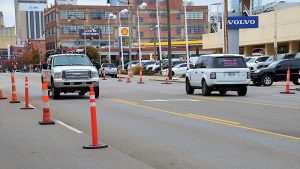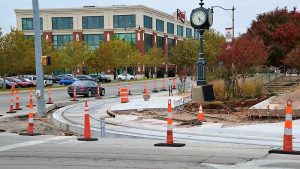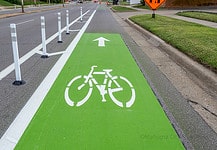Last Updated on November 13, 2017, 12:31 PM | Published: November 13, 2017
Will the new streetcars in downtown Oklahoma City end up in traffic snarls just like a car would? It’s a question several readers recently asked us.
Those closest to integrating streetcars with the rest of OKC traffic say they are working to make that a minimal concern.
After decades of development, and then beefing up the technology in recent years, the city’s computerized traffic system should coordinate the smooth flow of traffic including streetcars, automobiles, bicycles and pedestrians.
Oklahoma City’s streetcar system will have the first cars in operation in late 2018.
Signal priority?
In recent weeks Free Press has heard more and more city residents asking how streetcars will share the street with all other traffic.
People who work downtown seem to have that question on their minds these days because of current traffic conditions.
Construction to install streetcar tracks and stations along existing streets is well underway creating a new set of traffic frustrations weekly.
It’s easier to imagine a traffic mess when stuck in a traffic mess.
So, will the streetcars have signal priority, which would mean they would have traffic lights clear the way for them as they approach?
Yes, but
When Free Press started asking this question to city staff after the City of Oklahoma City Council meeting Tuesday, the responses were along the lines of “yes, but … .”
Jason Ferbrache, director of Central Oklahoma Transportation Authority, or COTPA, doesn’t think it will end up being the issue some might imagine at present.

“COTPA does support signal priority,” Ferbrache told us at the end of the council meeting.
But, streetcars will not have absolute priority at all signal lights because that would actually create a new set of traffic problems, he said.
Streetcars need to be a part of a larger flow of traffic that includes pedestrians, bikes and cars.
Especially in the early months of operation, supervisors will closely coordinate the progress of streetcars around their routes to make sure the frequency of arrival is consistent , Ferbrache said.
That’s the human side of streetcar operations.
For the technical integration of streetcars into the larger traffic system, Ferbrache referred us to another department.
Intelligent traffic
The streetcars will be an integral part of a larger “intelligent traffic” system that has been being built over the past several years with 2007 bond money says Shannon Cox with the Public Works department.

The key will be a high-tech system where the streetcar will automatically communicate with control boxes at signalized intersections through a system called Train-to-Wayside Control.
Those signal control boxes are part of a large, citywide computerized traffic control system that makes for a more even flow of traffic throughout the city by controlling the sequence of red and green lights according to the traffic load at the time.
Train-to-Wayside Control will integrate the position of the streetcar into the traffic light control system with the goal of creating a flow of all types of traffic.
Cox said there are some intersections where the streetcar will have signal priority in order to make safe turns into oncoming traffic.
She pointed out two intersections as examples.

The intersection at NW 11th Street and N. Broadway Avenue will have a traffic light that will stop oncoming traffic so the streetcar can make a left turn from Broadway onto 11th as it starts its inbound leg.
The intersection of Joe Carter Avenue and Reno Avenue on the east side of the Bricktown Ballpark is the other example Cox gave.
The streetcar will need to turn into the right lane of Reno eastbound. In order to do that safely, the streetcar will need signal priority to hold the light until it has made the turn.
Process
One concern Cox and Ferbrache expressed in separate interviews was that the public would think once streetcars were running, the development process will be complete.
Both said it won’t.
In fact, they confirmed that once streetcars are operating, the next phase of making a system that works well begins.
Ferbrache said operators and their supervisors would be constantly learning how to better run the system.
Cox said the integrated system would be undergoing constant review as traffic data including the streetcars pours in from the integrated traffic system.
“While the streetcar is in testing, MAPS, EMBARK and Public Works will continue to use this experience to assess prioritization needs,” said Cox.
Founder, publisher, and editor of Oklahoma City Free Press. Brett continues to contribute reports and photography to this site as he runs the business.










